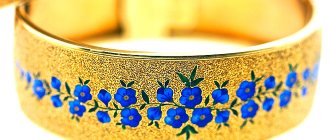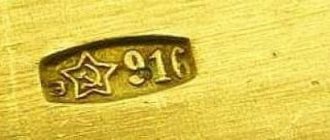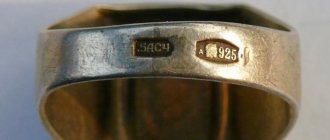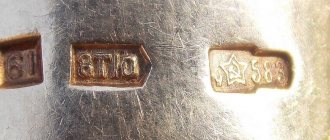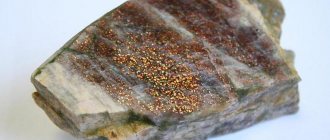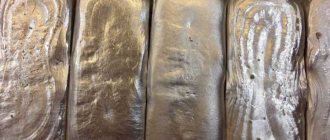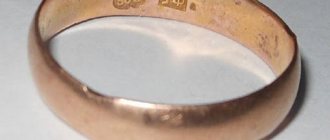Post updated: May 25, 2020
Palladium is a member of the platinum group metals and is at the same time considered a noble and rare element. This precious metal exists in nature in the form of compounds: according to scientists, Pd is part of about 30 minerals. The element is also found in its native form, but very rarely. The metal is in many ways similar to platinum; outwardly it is difficult to distinguish them from each other. Precious metal nuggets contain iridium, silver, platinum and gold. The physical and chemical properties of the element allow it to be widely used in the chemical industry and electronics, and its status as a precious material allows it to be used as a raw material for jewelry.
Discovery of new silver
Palladium was discovered by scientist William Wollaston in 1803. He, together with his colleague Smithson Tennant, studied the properties of platinum dissolved in the so-called aqua regia - a mixture of concentrated nitric and hydrochloric acids. The purpose of their research was to find the practical value of platinum, but it all turned out to be the discovery of rhodium and palladium by Wollastan and iridium and osmium by Tennant.
Unlike Tennant, Wollaston did not immediately announce his discovery, but did it in a very original way: in April 1803, he sent leaflets to members of the scientific community in London describing the properties of the “new silver” and indicated that it could only be bought in a well-known store for the sale of minerals. The store owner, Jacob Forster, received a package with metal samples and the same leaflet on the same day.
Of course, all this was done anonymously, so it aroused great suspicion among scientists. They immediately bought palladium in order to conduct research on it and expose the counterfeit, but this was not particularly successful. Chemist Richard Chenevix, having conducted many experiments with the support of eminent scientists of the time, suggested that this was not a new metal, but an alloy of platinum and mercury. Many colleagues supported him, although they noted that they found neither platinum nor mercury in the composition .
In December of that year, as interest in the new silver began to wane, a scientific journal published an anonymous advertisement that anyone who could isolate palladium in the presence of any three chemists appointed by the editor of the journal would be paid £20. However, no one was able to do this.
In June of the following year, Wollaston published a report on the discovery of rhodium, which is found in natural platinum. He noted that it probably also contains palladium. And in February 1805, he finally told the scientific community that he was the author of those anonymous leaflets.
average cost
Palladium is one of four metals that require mandatory hallmarking. In addition, samples are taken for silver, gold and platinum.
Palladium 500 and 850 are most often used to make jewelry. These are fairly cheap materials. Their cost is significantly lower than gold.
However, for wedding rings, material of the maximum 950 standard is often used. In terms of price, such jewelry is catching up with platinum products, but the cost depends on the design, brand and availability of stones.
The simplest palladium rings today can be purchased for 4-5 thousand rubles. These are mass-produced models that look quite decent. More complex and heavy products decorated with stones cost an average of 25-30 thousand rubles.
Leading jewelry houses also paid attention to this metal. A collection of wedding rings from it was created by Tiffany designers. The cost of one copy reached several thousand dollars.
Extraction methods
Most often, palladium is not mined in its pure form, but as part of alloys with gold, nickel, platinum or other metals. Palladium nuggets are extremely rare. There are two types of deposits:
- indigenous;
- placer.
In primary ores it is mined by processing copper or nickel ores, in alluvial ores - in its pure form, but they occupy only 2% of the total amount mined. Most often, nuggets are found at ore mining sites.
One of the largest mining sites is located in Russia , others are in the USA, South Africa, Austria, Canada and Colombia. The Russian deposit is in the Urals; at the moment its resources are almost exhausted.
Advantages and disadvantages
Palladium jewelry has many advantages and a number of disadvantages. The advantages of the products include:
- high strength comparable to platinum;
- heat resistance: products do not expand or deform;
- hypoallergenic;
- pleasant white shine and beauty;
- affordable price and breadth of product range;
- lightness and versatility.
Many young couples order palladium wedding rings. Especially if one of the newlyweds is allergic to gold or silver jewelry.
The disadvantages of jewelry earrings, rings and chains made of palladium include only the low popularity of the alloy. And also the need to update the polish to maintain the shine of the surface.
Metal properties
Palladium is a chemical element, in the periodic table it is located at position 46. It belongs to the noble metals, although it is used not only in jewelry, but also in industry. In nature, it consists of six stable isotopes; the seventh, an artificial radioactive isotope, has a half-life of more than seven million years. Can be formed during the fission of uranium and plutonium nuclei in nuclear reactors.
The melting point of palladium is 1554 degrees Celsius, density is 12 g/cm3. It is approximately one and a half times heavier than iron, but among the metals of its series (platinum, iridium and osmium) it is almost twice as light as all others. Compared to these metals, it is much easier to process - which is why it is highly valued in jewelry.
Palladium looks like a silvery-white metal. It is dense, corrosion resistant and paramagnetic. Even with the addition of 1%, it significantly improves the acid resistance of titanium. Scientists have attributed this phenomenon to the self-passivation (self-protection) of metals: if even a small dose of noble metals is introduced into alloys based on titanium, chromium, lead or iron, their corrosion resistance increases tens and even hundreds of times.
Palladium is the most reactive platinum metal. It does not react with water, dilute alkalis, acids and ammonia; it reacts only with hot concentrated sulfuric and nitric acids.
Its exceptional chemical properties are due to the fact that the outer orbit of its atom contains 18 electrons, that is, it is completely filled. Thanks to this, the metal is almost not exposed to external destructive effects of various substances. In order for them to interact, it is necessary to provide a high temperature - from 500 degrees Celsius.
Another interesting property of palladium is that it can absorb certain gases in large quantities. At room temperature, 1 cm³ of metal can absorb up to 800 cm³ of hydrogen. After this, the metal changes: it swells, cracks and swells. The metal is obtained by processing silver, nickel and copper. About 10% of global production comes from recycling.
Tips for choosing
If the choice is made in favor of palladium rings, it remains to give some advice on selection.
- Pay attention to the sample! The higher it is, the more clearly all the advantages of this metal will appear. If possible, it is better to purchase 950 rings. This is a guarantee of quality;
- Choose the “right” headband. It should have a slightly curved shape inside. This position is the most comfortable. The ring will not rub or dig into your fingers, even if they are slightly swollen;
- Look for your design. Palladium makes it possible to create unique, stunningly beautiful products. You may not be able to buy them at your local jewelry store. Then it’s worth looking at the range of models presented on the Internet. You will definitely find what you need there!
Application in different areas
Due to its exceptional properties, palladium is widely used in various areas of life. It can be found in many everyday things:
- phones;
- computers;
- in jewelry alloys;
- radio components;
- in commemorative coins.
Most widely used in industry. It is used to purify hydrogen, as a catalyst (for example, to detect trace amounts of carbon monoxide), and in electronics.
In medicine, the use of metal is very wide: it is used to make instruments, dentures, parts for pacemakers and brachytherapy. In some countries, antitumor drugs used in complex therapy are obtained from it.
In jewelry, palladium is used to create white gold. Even with the addition of 1-2%, ordinary gold becomes white. Sample 585 usually contains 13% palladium. This alloy is best suited for setting precious stones. When added to platinum, it makes it more ductile.
In its pure form, palladium is too soft, so it is used only in alloys. This only improves the properties of the base metal: it becomes more resistant to external influences and is easier to polish. When producing white gold, palladium gives a white tint, while nickel gives a yellowish tint, and rhodium gives a blue tint.
If palladium is used to make jewelry, then it is not pure metal, but with an admixture of nickel, cobalt or ruthenium (the rest are used much less frequently). In Russia, standards for palladium are 500, 850 and 950.
The latter is used to make wedding rings. In appearance, they do not differ from products made from white gold, but they have an undeniable advantage: white gold is coated with rhodium so that it does not lose color, while palladium does not require this. Rhodium on gold wears off due to constant wear and contact with hands, so periodically the jewelry will have to be taken to a jewelry workshop for additional rhodium plating, while palladium will always retain its normal color.
In electronics, palladium is used for coatings and the production of flux chords, and is used in the production of military and aerospace equipment. Also, a special composition is made with it, which is applied to the parts and protects them from negative external influences and oxidation. Palladium is found in motherboards and ceramic capacitors.
Palladium
A ductile noble metal of white color, found in nature 10 times less frequently than gold and 40 percent lighter. Discovered by the English chemist William Wollaston in 1803. Named after the asteroid Pallas, discovered shortly before the metal itself. In turn, the asteroid is named after the Greek goddess Pallas Athena.
Palladium 950 is an ideal replacement for rhodium-plated gold.
White gold itself is not white. In order for jewelry made from it to have the familiar silvery white color, each product is coated with a thin layer of rhodium, which gives it this color. The original color of “white gold” in alloys produced in our country has a yellowish tint, which occurs due to the use of nickel as an alloy. The use of nickel is determined by the desire to reduce the final cost of the alloy as much as possible while giving it a white color and certain mechanical properties.
But it is not possible to achieve complete whiteness; moreover, nickel is the most allergenic metal of all existing ones. Therefore, to protect the skin and achieve a silvery white color, jewelry is rhodium plated.
In Western European countries, where the health of end consumers is much more concerned, the use of nickel in the creation of jewelry is prohibited at the legislative level. There, palladium is used in the ligature, which gives “white gold” a dark gray tint. Such products are then rhodium-plated to give them a silvery white color. In addition, in order to achieve optimal hardness of the alloy and maintain the ability for ordinary jewelers to work with it, the percentage of palladium in the alloy does not exceed 18%.
Rhodium coating, like any other coating, wears out over time. And if for earrings, pendants and chains the wear period of the coating can be very long, then for wedding rings, which, as a rule, are not removed at all, the issue of how long the coating wears out is very significant. Therefore, the main question facing jewelers today is achieving a silvery white color without coating, with appropriate hardness and safety for humans.
There is no such solution for gold yet, but it was found using Palladium 950
In 2007 In Germany, the Palladium 950 alloy was developed for the production of wedding rings, which solves all these problems, except one - ordinary jewelers cannot work with it, since the alloy is not cast, but requires mechanical processing. In Russia, all wedding rings are mostly produced using casting, and in Europe by processing specially made blanks on robotic machines.
Palladium 950
— Noble metal of the platinum group.
— Palladium is as rare as platinum.
- Absolutely anti-allergenic.
— The alloy contains 950 fineness – 95% pure palladium.
— The cost is the same as 750 gold (75% pure gold in the alloy).
— The hardness is almost like that of platinum 950 (PtW Germany), and higher than that of Russian platinum 950 (PtCu) by 80%, Russian gold 750 by 70%, than that of German gold 750 by 25%.
— The color without coating is silvery white, like rhodium plated products.
In Russia, 850 standard palladium is used to make jewelry.
Products are made mostly by stamping to give the metal hardness.


